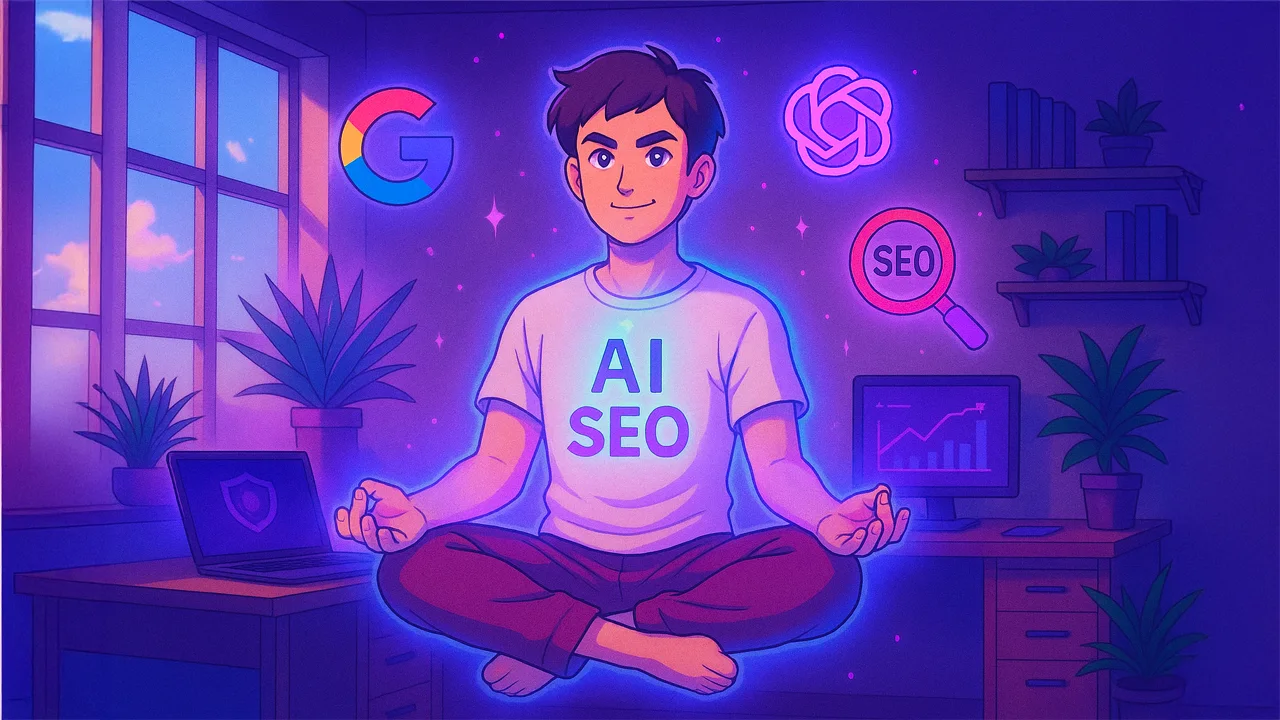
AI SEO: The Ultimate 2025 Guide
The way people find information has fundamentally changed. Ever since ChatGPT launched three years ago, we’re slowly seeing that regular Google searches are fading fast because people now have an AI chatbot to ask questions to.
This much smarter, more personalized era of AI in search discovery is transforming the way businesses are being discovered since search is no longer limited to the Google search box and the Google search results.
See impact of AI in search →
This new evolution of search requires a new framework to build business discoverability and that’s where AI SEO comes in - designed specifically to get your content seen, selected, and cited by engines like Google’s AI Overviews and chatbots like ChatGPT.
What is AI SEO or GEO?
In a nutshell, AI SEO also known as Generative Engine Optimization (GEO), is a technical approach to do the following:
- Optimize content for AI Search discoverability,
- Leverage AI to build a content strategy by understanding user intent, and what other questions they may have, and
- Enhancing the scope of content using techniques like vector embedding and cosine similarity to discover the gap in the current content, and knowing how to close them
- Tracking your brand and competitor brand mentions on AI chat
We will get into vector embeddings and consume similarity in a different article as that is a whole new beast which requires powerful AI-powered tools to accomplish.
Why should I care about AI SEO?
The stakes couldn’t be higher. As of mid-2024, more than 58% of Google searches didn’t result in a single click, often because the answer was already provided by a snippet or the AI overviews on the page . With approximately 30% of all queries now triggering an AI Overview and Google’s new AI Mode set to become the standard, the new battleground for visibility is clear.
Here’s an interesting statistic about the people you’re trying to reach today - according to Forrester, 64% of business buyers are Millennials or Gen-Zers who grew up with digital-first habits. In an enterprise, they’re part of buying committees that can include 7 or more people. Today, all of them are turning to AI to get informed, find recommendations. Because, who doesn’t want to sound the smartest and the most informed in their meetings?
Your success now depends on one thing: being the answer an AI chatbot chooses to cite when your buyers ask questions, and becoming the business it recommends.
I mean, read this LinkedIn post from the Co-founder and CEO of TravelAI:
This ultimate guide will show you exactly how to get conversion-ready traffic and leads from AI chatbots.
In this guide, you will learn:
- The foundational principles of AI SEO and how they build on traditional SEO.
- How to get your content featured in Google’s AI Overviews.
- Specific tactics to optimize for ChatGPT, Claude, and other major chatbots.
- A complete, four-pillar action plan covering content, structure, technical SEO, and authority building.
- What the future holds with the rise of the “agentic web.”
- So, how do you get into these critical AI conversations? Let’s dive in.
How is AI SEO different from SEO?
Now that you know why AI SEO is critical, I am going to tell you in the next 3 minutes about what I’ve learned and experienced over the last 3 years.
Despite all the wizardry in these systems, and how magically incredible all this looks like, the current reality is that AI SEO doesn’t fully replace traditional SEO; it builds directly on top of it.
There is a lot more foundational focus on structured data and technical SEO as you will discover. However, the most important transformation is the content strategy itself.
Showcasing Experience and Expertise (EEAT)
At the core of this foundation is a principle that has become non-negotiable in modern search and content development: E-E-A-T. This is Google’s acronym for Experience, Expertise, Authoritativeness, and Trustworthiness. If a content has to rank well, whether in a traditional search engine or an AI, it must demonstrate these qualities.
Both traditional ranking systems and new AI models are designed to favor content that is accurate, trustworthy, and clearly shows a high level of expertise, at least in what I’ve been seeing across most AI chatbots.
To learn more about what EEAT really is, please see the link above as I will not be going through that in this article for the sake of brevity.
Trustworthiness and Credibility
Here’s the bottom line: Strong organic rankings are essentially a prerequisite for AI visibility. AI engines are designed to pull from sources they already deem credible, and high search rankings are a powerful signal of that credibility.
The statistics below makes this crystal clear:
- A Jan 2025 study by Seer Interactive discovered a strong correlation of about 0.65 between a brand ranking on Google’s first page and being mentioned in Large Language Models (LLMs) like ChatGPT.
- The connection is even more direct with Google’s AI Overviews. Research shows that a staggering 75% of the links featured within these AI summaries come from websites that already rank in the top 12 organic search results for that same query. Google’s new AI mode is an expansion of AI overviews with the ability to have a conversation similar to Perplexity - it’s also the same.
Simply put, you need to earn your place on the first page of Google to even be considered for the AI showcase.
Your traditional SEO efforts are what get you past the velvet rope; your AI SEO strategy is what makes you the star of the party.
What this basically boils down to is this: How spread is your authority across channels that your buyers use - website, YouTube (learning and conversations), Spotify (podcasts), Industry Publications and so on? And is it consistent?
Mastering AI SEO for Google: Winning the AI Overview
SERPs (Search Engine Results Pages) used to have snippets before. Now those have been replaced by an the AI Overview (AIO).
Just like featured snippets, these AI-generated summaries sit right at the top of the page, giving users an instant answer. On the right side of the AIO are links of websites that Google referenced.
In June, Google started rolling out AI Model in the US. Now, it is also in India. Although these are Search Labs features, they will pretty soon become the standard search interface - it’s only a matter of time before Google makes AI mode the default search interface because they’re readying this for the agentic web.
A key part of AI SEO is understanding the secret handshake which is knowing what kind of content actually triggers these AI Overviews or citations in AI mode conversations in the first place.
What triggers Google’s AI Overview?
Not all queries trigger a Google AI overview. In our research, we found that AIOs are most often triggered by:
- Informational Intent: These summaries thrive on queries where users are looking for a comprehensive, synthesized answer, not just a quick link.
- Query Length: Forget one-word searches. Longer, more specific questions are far more likely to get the AIO treatment.
- Question-Based Queries: It pays to be direct. Research shows that about 31.6% of all AI Overviews appear in response to explicit questions.
We’re still analysing the correlation between search volume of a keyword phrase and the appearance of AI overviews - so far, there seems to be no correlation between them.
Some experts initially said that a Google AI overview could show up for keyword phrases with a higher CPC, but that hasn’t been necessarily true either at least in the sampling of 20 phrases we looked at - it has been random.
But one thing seems to be clear, if the phrase is a long question (long-tail keywords) that typically outside the scope of keyword research, it has triggered a Google AI Overview.
For a deep dive, see how Google AI overviews work →
How to appear in Google AI Overviews?
So, with that information, how do you ensure your content is the one Google picks for its answer? Here are the keys to the kingdom:
- Content Quality & Relevance: This one’s a no-brainer. Your content must directly answer the user’s question, and it helps to do so in a natural, conversational tone. No one, not even an AI, likes reading a textbook.
- How do you find these questions? Tools like AlsoAsked and AnswerThePublic are excellent at this. You could also just search on Google to find “People also ask” for the question you’re trying to optimize for.
- Content Structure & Formatting: AIs read for efficiency. Using clear headings (hopefully this page is a good example), bullet points, and lists is crucial for AI parsing. A well-organized page is an easily understood page.
- Authority Signals: Google has to trust you before it promotes you. It heavily prioritizes domains with strong authority signals like healthy traffic, quality backlinks, and overall trustworthiness. This one is basically regular SEO.
Real-world example: Here’s a screenshot of our client showing up in Google’s AI overviews. They’re a 50-person IT consulting company and using AI SEO, they basically were able to beat billion dollar competitors like Accenture, Infosys, KPMG and others for a clinical supplies solution for the pharma industry.
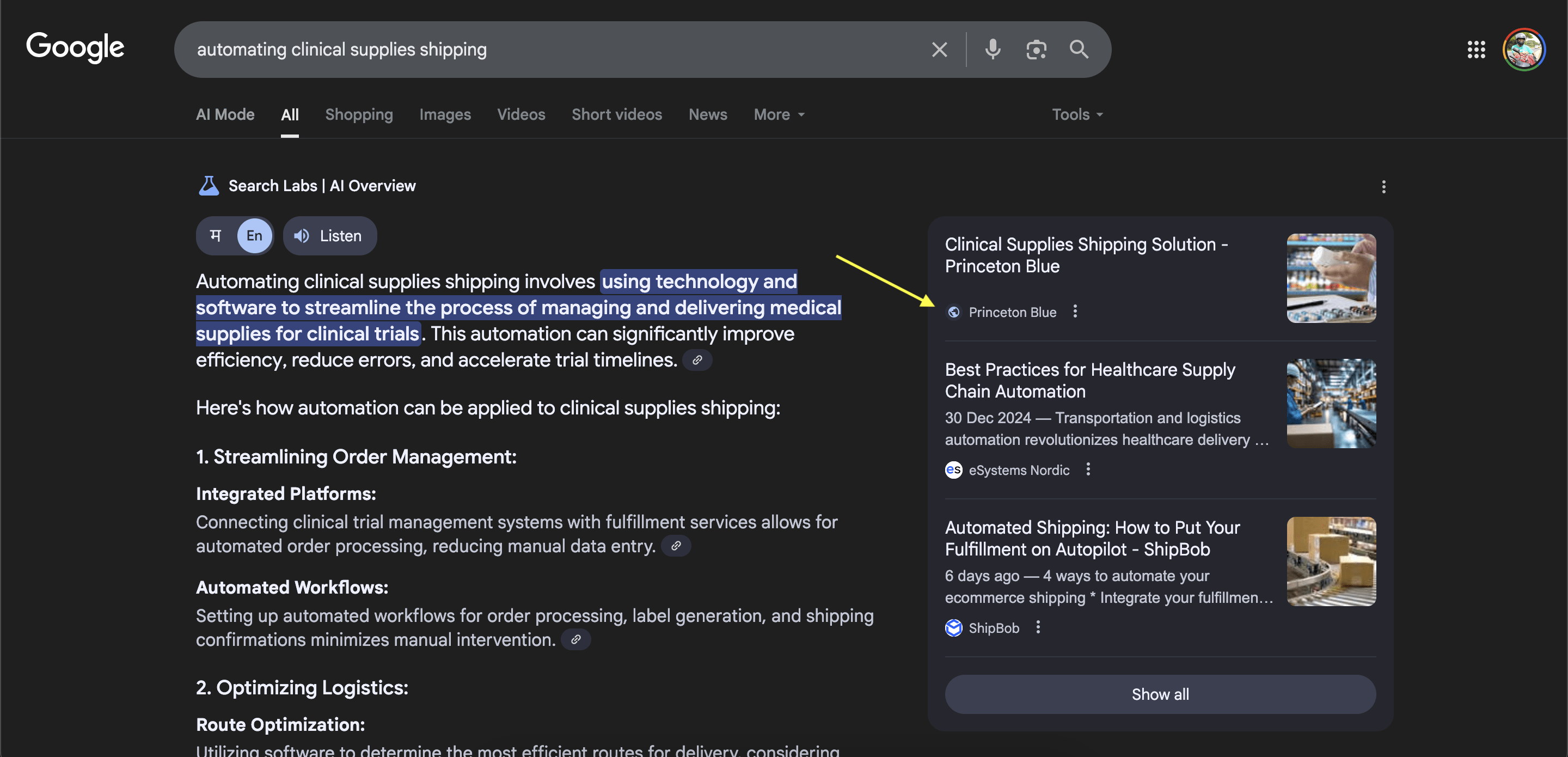
How to get your business recommended by ChatGPT and other AI Chatbots?
Winning the Google AI Overview is a huge victory, but it’s only one part of the new search landscape.
Having said that, since most AI LLMs are trained on web data, if you’re showing up in AI overviews, it is highly likely that your business will also start being mentioned in AI chat conversations.
Of course, a truly complete AI SEO strategy needs to be flexible, adapting to the different AI platforms where your audience is seeking answers. Each platform has its own personality and quirks, and learning to speak their language is the key to multi-platform success.
How ChatGPT searches the internet
ChatGPT has a peculiar and important habit: it often acts as a translator. It takes a user’s simple question and rewrites it into a more specific, detailed search query before looking for answers. It frequently adds intent-rich words like “guide,” “tutorial,” “steps,” or even the current year (like “2025”) to get better results.
This excellent bookmarklet from Ziggy Shtrosberg helps identify what queries ChatGPT actually uses when web search is enabled for a chat.
Your Tactic: Stop optimizing just for the simple question a user might ask. Your AI SEO keyword strategy should target these transformed, more specific queries that ChatGPT is actually searching for. You’re not just answering the user; you’re answering the AI’s more sophisticated version of the question.
For a deep dive, see how to get recommended by ChatGPT and other AI chatbots →
Real-world example: A searcher asks ChatGPT a question about their current research.
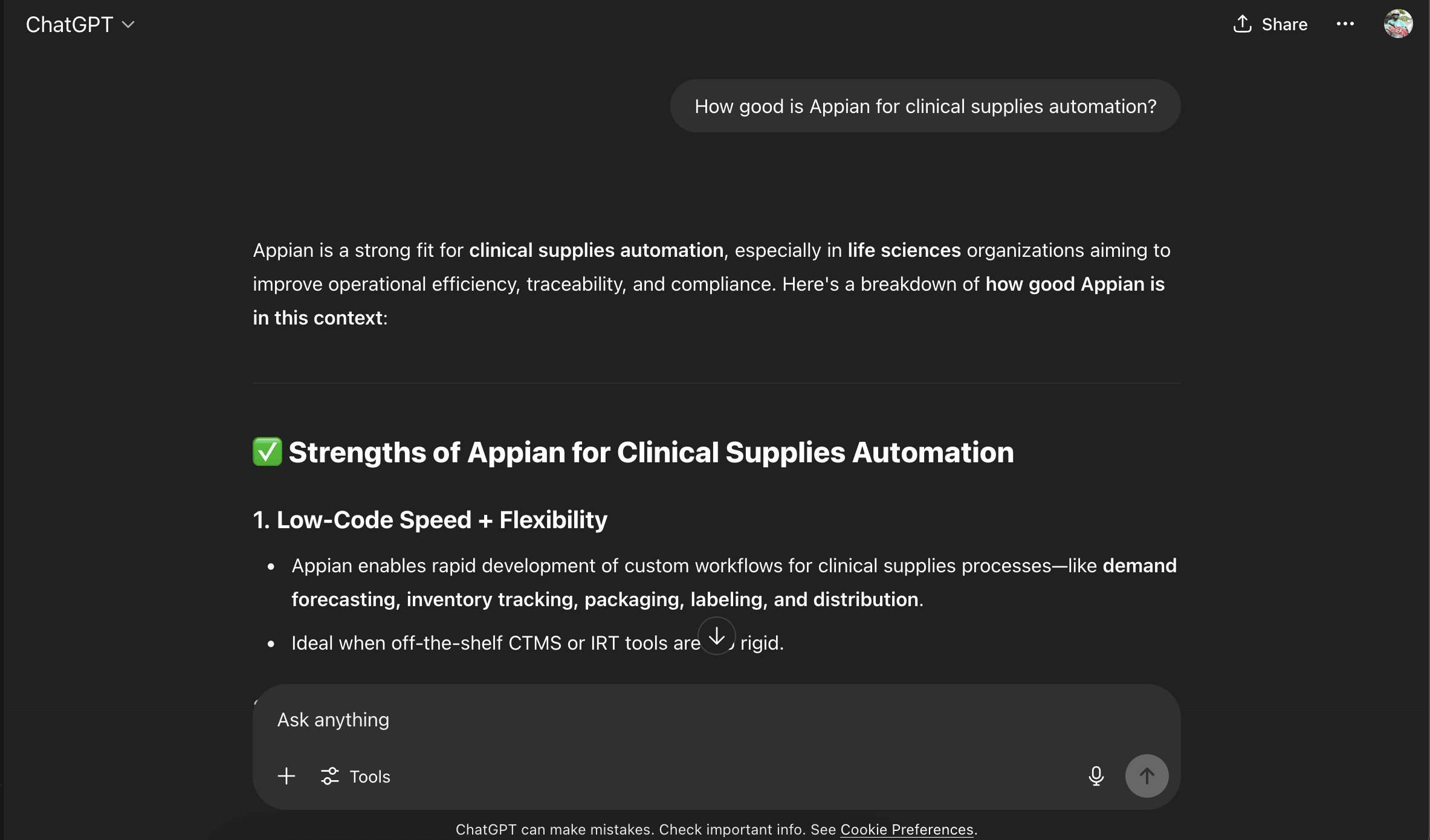
Here’s a screenshot of our client being referenced and recommended by ChatGPT for a similar question as the Google AI overview above. Appian is a large company with partners like Accenture, Infosys, KPMG, Deloitte, and more who all have a pharma practice in their companies.
But our client is recommended by AI first - because they focus exclusively on the Pharma industry, and have a lot of experience. Therefore, we amplified this experience and positioned them as the go-to-Appian partner for the pharma industry.
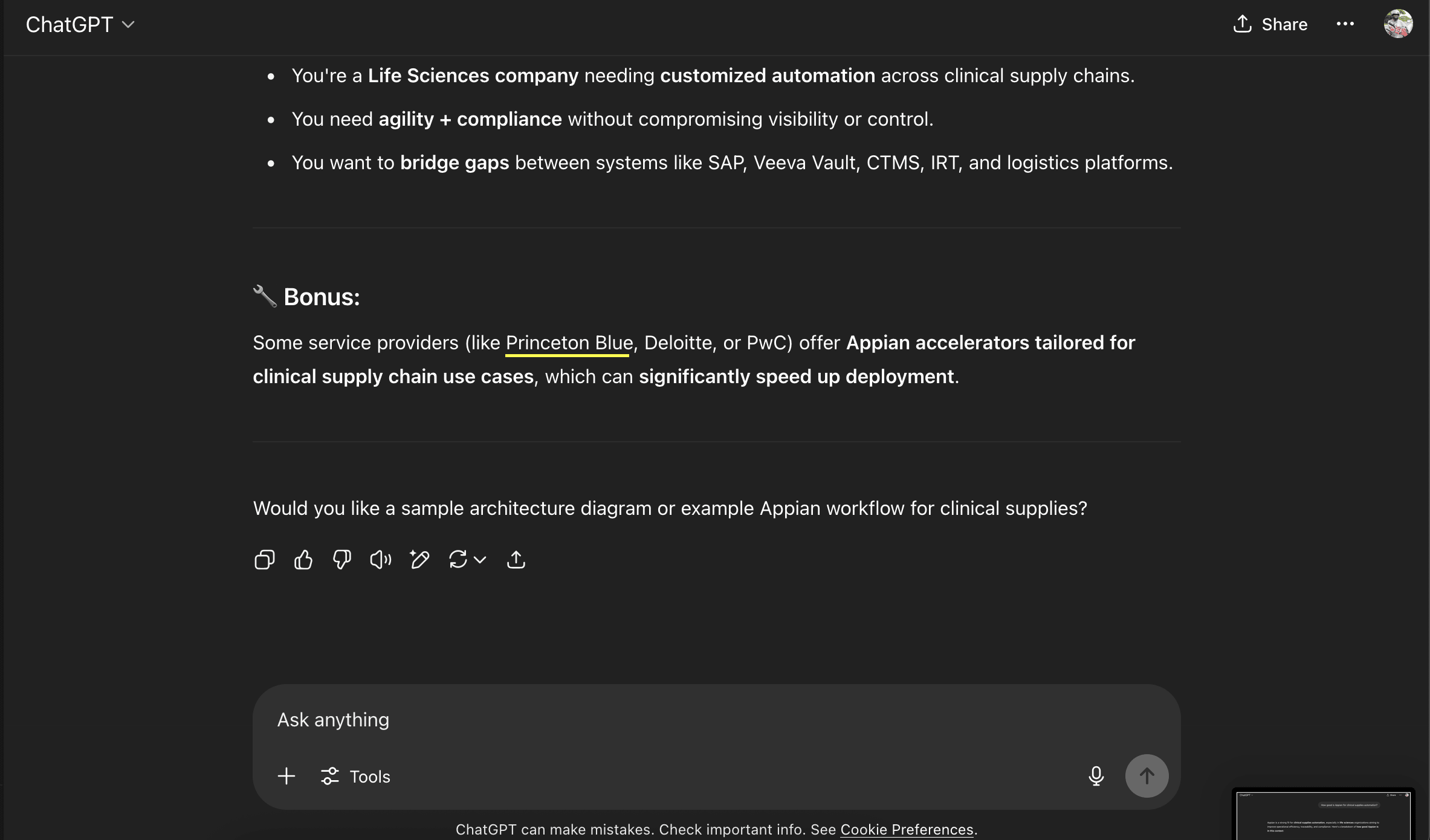
AI SEO for Claude & Perplexity
On the other side of the spectrum are platforms like Claude and Perplexity. They position themselves as transparent “answer engines,” making it a point to always cite their sources clearly. Both value credibility and authority above all else.
The below screenshot is a Perplexity search that clearly shows what queries it is using to search the web, find sources and select those sources to synthesize an answer.
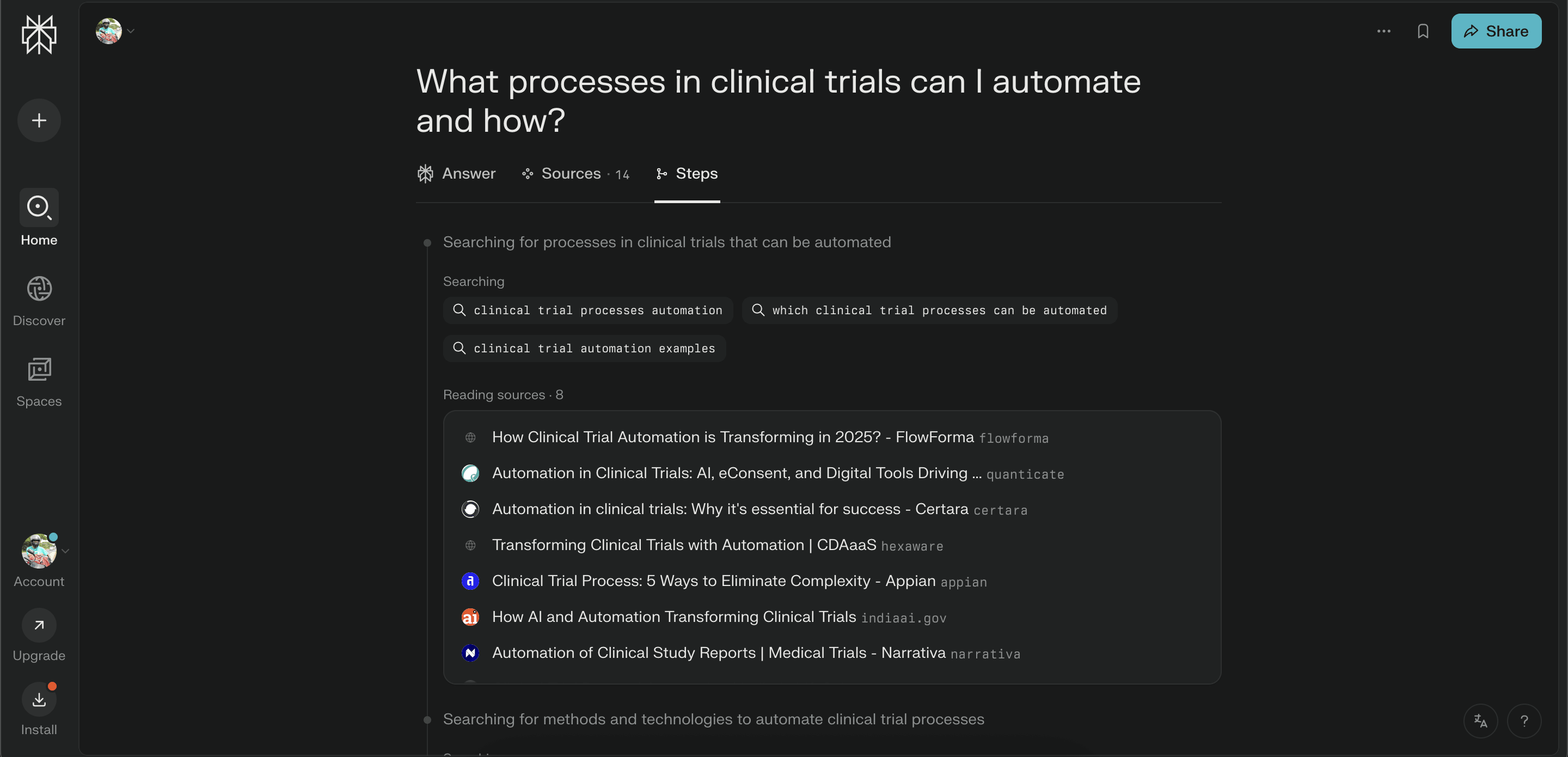
Your Tactic: The best way to win here is to become an unimpeachable source of truth. Focus on creating authoritative, well-researched content. The winning format is “answer-first” content, which means crafting modular, easy-to-digest blocks of text that directly and comprehensively answer a single, specific question. Make it easy for them to grab your expert answer and cite you as the source.
Claude and Perplexity value authority and rankings over ChatGPT due to the nature of their crawlers. Currently, the best approach to build authority is to get your business mentioned (and get backlinked if possible) from authoritative publications in your industry.
Your 4-piece AI SEO Action Plan
Alright, it’s time to get tactical. A winning AI SEO strategy rests on four key pieces. Before getting into advanced AI SEO, I highly recommend getting these foundational pieces in place because you will start seeing results in 3-4 months. But, this is actually important for long-term success in the new age of search.
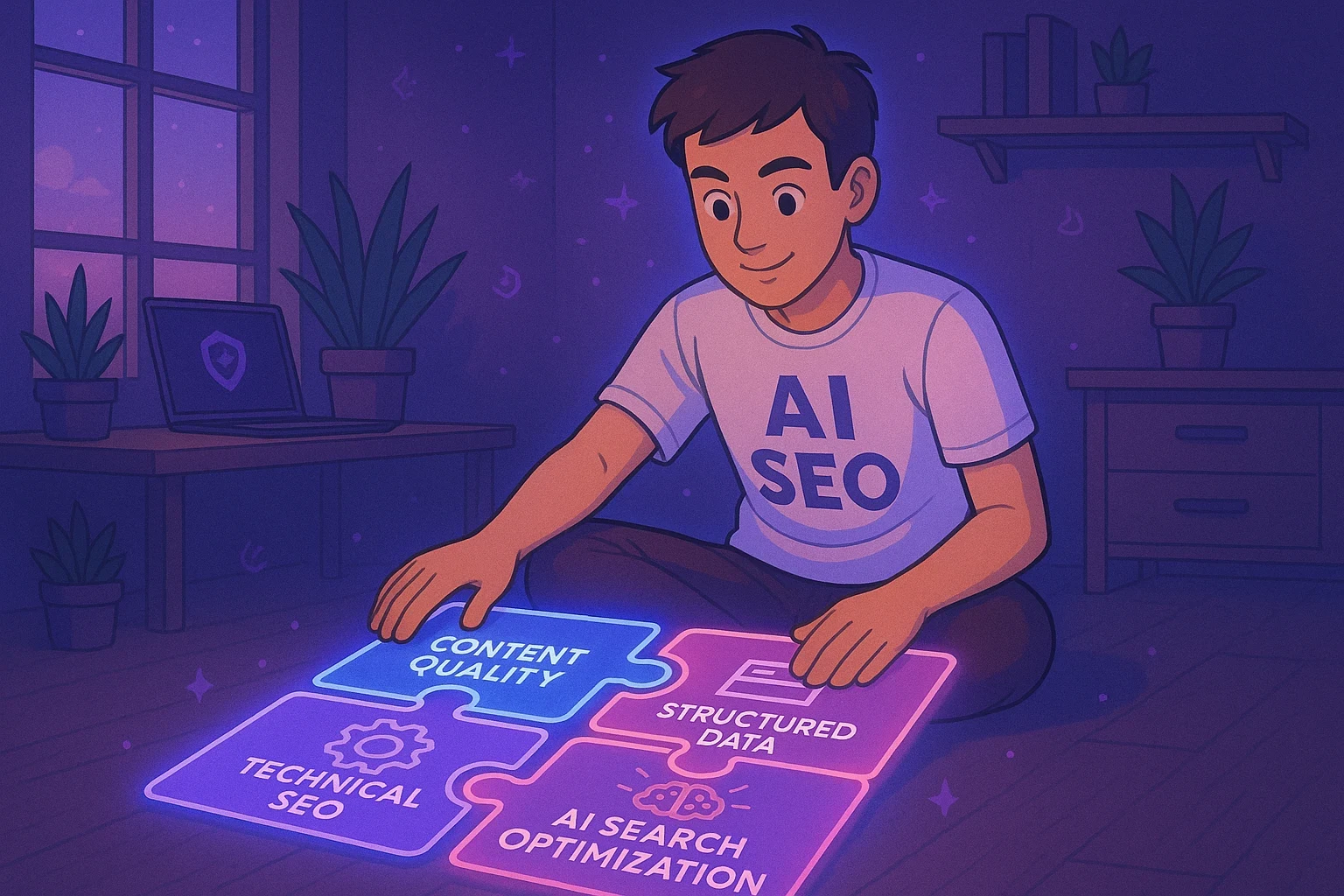
Piece 1: AI SEO Content Creation
This is the heart of your strategy. Your content has to be more than just good; it has to be AI-friendly.
- Demonstrate E-E-A-T: You must consistently prove you know your stuff. Back up your claims with credible sources, showcase your authors’ credentials and experience, and always ensure your facts are spot-on.
- Answer Directly, Then Elaborate: Think of your blog posts or content as a prospect asking a question. If you were talking to them, you’d give them a direct, no-nonsense answer right away, and then, you’d take them deeper into the topic. Written content must reflect a conversational approach. After you’ve given them the answer, explore all angles of the topic and anticipate what other related questions someone might have.
- Write for Clarity: Jargon and overly complex sentences are poison for AI SEO. Use simple, straightforward language that is easy for both humans and AI algorithms to quickly understand.
Piece 2: Conversational Structure
How you say something is just as important as what you say. Your content needs to be structured for easy digestion.
- Format for Scannability: Use clear headings (H2s, H3s) to logically organize your content. Employ bullet points and numbered lists to break down processes or key information into bite-sized, easy-to-digest pieces.
- Add FAQ Sections: Including a dedicated FAQ section in your articles is a brilliant move. It directly addresses potential follow-up questions and significantly increases the chance your content will be featured by AI. Don’t forget to use
FAQPageschema to mark it up properly.
Piece 3: Technical AI SEO
This is where you give the AI a cheat sheet to understand your website’s content perfectly.
Implement Structured Data: This is absolutely crucial. Schema markup adds explicit labels to your content that AI can read, helping it understand the context of what’s on your page. Use relevant types like Article, HowTo, VideoObject, and more.
- Optimize Multimodal Content: Your AI SEO efforts must go beyond text. Ensure all your images have descriptive alt text and that videos have transcripts, using the appropriate
ImageObjectandVideoObjectschema for them. - Core Web Vitals: The basics are still critical. Your website must be fast, mobile-friendly, and secure (served over HTTPS) to ensure a good user experience and easy crawlability for AI. Although HTTPS is a web standard now, I’m still going to leave this here for the sake of completeness and importance.
Piece 4: Building Authority Signals
For an AI to trust you, it needs to see that others trust you too.
- Authoritative Backlinks: A strong, high-quality backlink profile is still a bedrock of good SEO (for now). It builds your overall domain authority, which helps you rank higher and get on the AI’s radar in the first place. However, a good long-term plan would be to start getting mentioned in highly credible and authoritative publications in your space.
- Positive Reviews: Don’t underestimate social proof. AI systems are increasingly analyzing reviews for sentiment and context, prioritizing content from businesses with strong positive feedback.
- Thought Leadership: Position your brand as a go-to expert. Publish original research or data-driven reports to create unique, citable content that AI systems will see as a credible source.
The Agentic Web and the Future of AI SEO
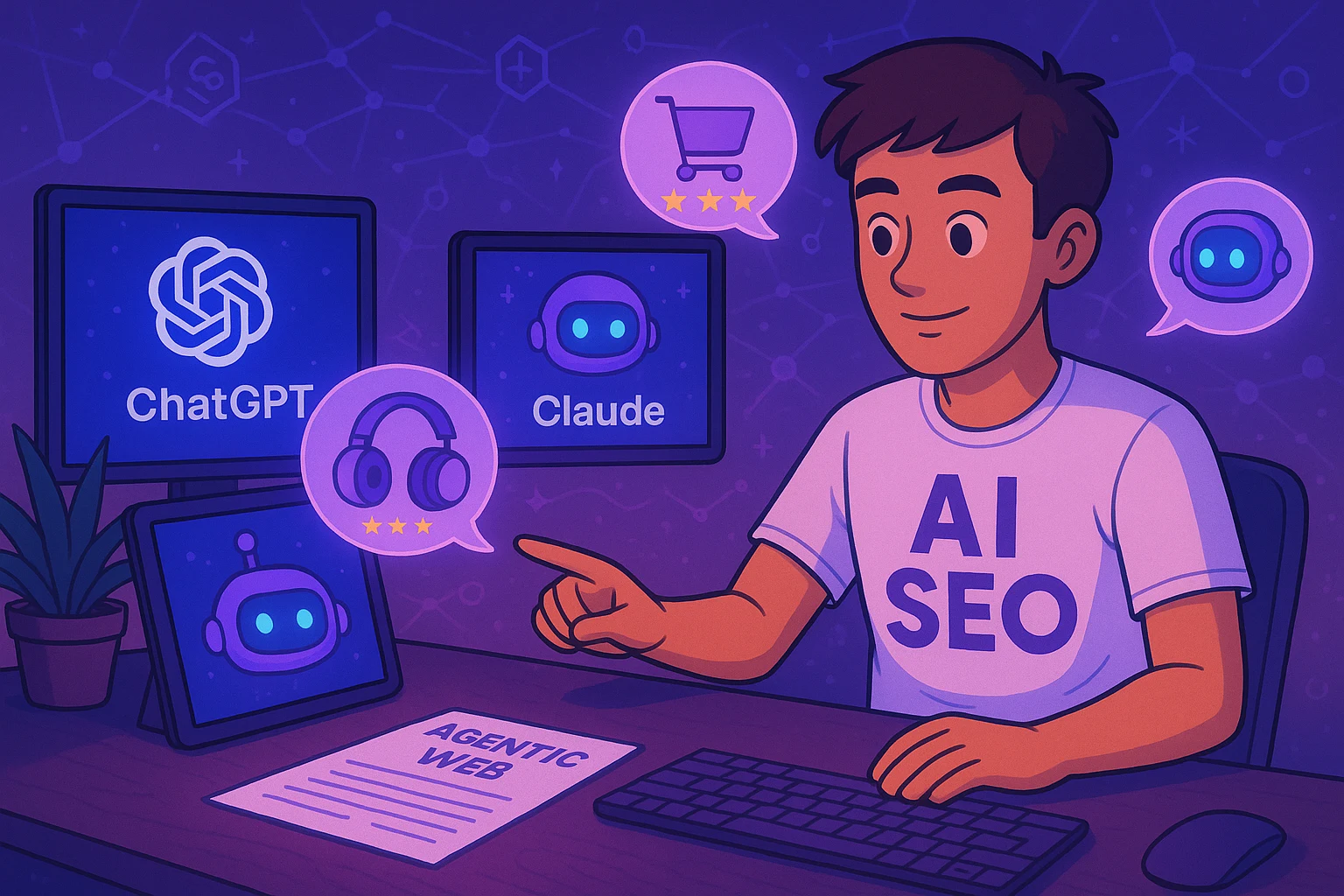 At this point, AI SEO isn’t just another buzzword or a task you can check off a list. It’s a fundamental shift in how you must approach your entire digital strategy.
The future is already unfolding with the rise of the “agentic web,” where sophisticated AI agents won’t just find information, but will act on a user’s behalf, executing complex, multi-step tasks.
At this point, AI SEO isn’t just another buzzword or a task you can check off a list. It’s a fundamental shift in how you must approach your entire digital strategy.
The future is already unfolding with the rise of the “agentic web,” where sophisticated AI agents won’t just find information, but will act on a user’s behalf, executing complex, multi-step tasks.
Many companies have already built protocols like the Agent-2-Agent protocol by Google or the NLWeb by Microsoft that can interface with websites to perform actions and these are actively being tested across companies.
From an AI SEO perspective, you’ll need to optimize your content not just for direct answers, but to be easily digestible and actionable for these autonomous agents. This is a profound shift from helping users “find information” to helping them “get tasks done,” and it’s where this journey is heading next.
The most important thing to remember is that this landscape is a rapidly moving target. AI SEO isn’t a “set it and forget it” task; it’s an ongoing discipline that demands a commitment to continuous learning, testing, and adapting your strategies to remain effective.
If you’re reading this, you probably already know more than 80% of the people in your field. To stay up to date on the latest shifts and how this impacts your role and your business discoverability, subscribe to our bi-weekly newsletter.
If you have any questions, feel free to send us a message.
